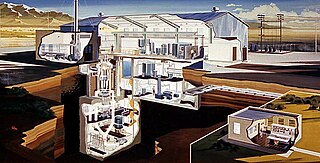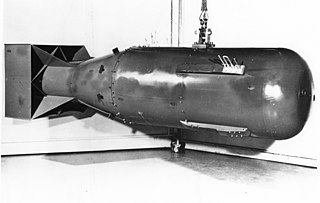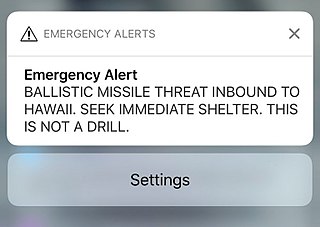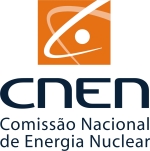 W
WWorldwide, many nuclear accidents and serious incidents have occurred before and since the Chernobyl disaster in 1986. Two thirds of these mishaps occurred in the US. The French Atomic Energy Commission (CEA) has concluded that technical innovation cannot eliminate the risk of human errors in nuclear plant operation.
 W
WNuclear safety is defined by the International Atomic Energy Agency (IAEA) as "The achievement of proper operating conditions, prevention of accidents or mitigation of accident consequences, resulting in protection of workers, the public and the environment from undue radiation hazards". The IAEA defines nuclear security as "The prevention and detection of and response to, theft, sabotage, unauthorized access, illegal transfer or other malicious acts involving nuclear material, other radioactive substances or their associated facilities".
 W
WThis article lists notable civilian accidents involving radioactive materials or involving ionizing radiation from artificial sources such as x-ray tubes and particle accelerators. Accidents related to nuclear power that involve fissile materials are listed at List of civilian nuclear accidents. Military accidents are listed at List of military nuclear accidents.
 W
WThis is a List of nuclear and radiation fatalities by country.
 W
WA nuclear and radiation accident is defined by the International Atomic Energy Agency (IAEA) as "an event that has led to significant consequences to people, the environment or the facility. Examples include lethal effects to individuals, large radioactivity release to the environment, reactor core melt." The prime example of a "major nuclear accident" is one in which a reactor core is damaged and significant amounts of radioactive isotopes are released, such as in the Chernobyl disaster in 1986 and Fukushima Daiichi nuclear disaster in 2011.
 W
WA nuclear meltdown is a severe nuclear reactor accident that results in core damage from overheating. The term nuclear meltdown is not officially defined by the International Atomic Energy Agency or by the United States Nuclear Regulatory Commission. It has been defined to mean the accidental melting of the core of a nuclear reactor, however, and is in common usage a reference to the core's either complete or partial collapse.
 W
WBanana equivalent dose (BED) is an informal measurement of ionizing radiation exposure, intended as a general educational example to compare a dose of radioactivity to the dose one is exposed to by eating one average-sized banana. Bananas contain naturally occurring radioactive isotopes, particularly potassium-40 (40K), one of several naturally-occurring isotopes of potassium. One BED is often correlated to 10−7 sievert ; however, in practice, this dose is not cumulative, as the principal radioactive component is excreted to maintain metabolic equilibrium. The BED is only meant to inform the public about the existence of very low levels of natural radioactivity within a natural food and is not a formally adopted dose measurement.
 W
WThe BORAX Experiments were a series of safety experiments on boiling water nuclear reactors conducted by Argonne National Laboratory in the 1950s and 1960s at the National Reactor Testing Station in eastern Idaho. They were performed using the five BORAX reactors that were designed and built by Argonne. BORAX-III was the first nuclear reactor to supply electrical power to the grid in the United States in 1955.
 W
WThe New Safe Confinement is a structure built to confine the remains of the number 4 reactor unit at the Chernobyl Nuclear Power Plant, in Ukraine, which was destroyed during the Chernobyl disaster in 1986. The structure also encloses the temporary Shelter Structure (sarcophagus) that was built around the reactor immediately after the disaster. The New Safe Confinement is designed to prevent the release of radioactive contaminants, protect the reactor from external influence, facilitate the disassembly and decommissioning of the reactor, and prevent water intrusion.
 W
WThe Chernobyl Nuclear Power Plant sarcophagus or Shelter Structure was a massive steel and concrete structure covering the nuclear reactor number 4 building of the Chernobyl Nuclear Power Plant. It was designed to limit radioactive contamination of the environment following the 1986 Chernobyl disaster, by encasing the most dangerous area and protecting it from climate exposure. It was located within a large restricted area known as the Chernobyl Exclusion Zone.
 W
WA nuclear close call is an incident that could lead to, or could have led to at least one unintended nuclear detonation/explosion. These incidents typically involve a perceived imminent threat to a nuclear-armed country which could lead to retaliatory strikes against the perceived aggressor. The damage caused by international nuclear exchange is not necessarily limited to the participating countries, as the hypothesized rapid climate change associated with even small-scale regional nuclear war could threaten food production worldwide—a scenario known as nuclear famine.
 W
WA containment building, in its most common usage, is a reinforced steel, concrete or lead structure enclosing a nuclear reactor. It is designed, in any emergency, to contain the escape of radioactive steam or gas to a maximum pressure in the range of 275 to 550 kPa. The containment is the fourth and final barrier to radioactive release, the first being the fuel ceramic itself, the second being the metal fuel cladding tubes, the third being the reactor vessel and coolant system.
 W
WControl rods are used in nuclear reactors to control the fission rate of uranium or plutonium. Their compositions includes chemical elements, such as boron, cadmium, silver, or indium, that are capable of absorbing many neutrons without themselves fissioning. These elements have different neutron capture cross sections for neutrons of various energies. Boiling water reactors (BWR), pressurized water reactors (PWR), and heavy-water reactors (HWR) operate with thermal neutrons, while breeder reactors operate with fast neutrons. Each reactor design can use different control rod materials based on the energy spectrum of its neutrons.
 W
WA core catcher is a device provided to catch the molten core material (corium) of a nuclear reactor in case of a nuclear meltdown and prevent it from escaping the containment building.
 W
WCorium, also called fuel-containing material (FCM) or lava-like fuel-containing material (LFCM), is a material that is created in the core of a nuclear reactor during a meltdown accident. It resembles natural lava in its consistency, hence the name.
 W
WThe Defense Nuclear Facilities Safety Board is an independent agency of the United States government based in Washington, D.C. Established in 1988, the DNFSB oversees the nuclear weapons complex administered by the U.S. Department of Energy. The DNFSB is independent of the Department of Energy. The DNFSB's most important power is its ability to give recommendations to the Secretary of Energy.
 W
WDuck and Cover is a civil defense social guidance film that is often popularly mischaracterized as propaganda.
 W
WThe Nuclear Emergency Support Team (NEST), formerly known as the Nuclear Emergency Search Team, is a team of scientists, technicians, and engineers operating under the United States Department of Energy's National Nuclear Security Administration (NNSA). Their task is to be "prepared to respond immediately to any type of radiological accident or incident anywhere in the world".
 W
WThe Gilbert U-238 Atomic Energy Lab was a toy lab set that was produced by Alfred Carlton Gilbert, who was an American athlete, magician, toy-maker, business man, and inventor of the well-known Erector Set. The Atomic Energy Lab was released by the A. C. Gilbert Company in 1950. The kit's intention was to allow children to create and watch nuclear and chemical reactions using radioactive material.
 W
WA Gravel Gertie is a type of bunker designed to provide containment during the nuclear weapons assembly process, when the plutonium or highly enriched uranium "pit" is mated with the high explosive components and wired into the electronics of the warhead.
 W
WOn the morning of Saturday, January 13, 2018, a ballistic missile alert was accidentally issued via the Emergency Alert System and Commercial Mobile Alert System over television, radio, and cellphones in the U.S. state of Hawaii. The alert stated that there was an incoming ballistic missile threat to Hawaii, advised residents to seek shelter, and concluded: "This is not a drill". The message was sent at 8:07 a.m. local time. Civil defense outdoor warning sirens were not authorized by the state.
 W
WA hazmat suit is a piece of personal protective equipment that consists of an impermeable whole-body garment worn as protection against hazardous materials. Such suits are often combined with self-contained breathing apparatus (SCBA) to ensure a supply of breathable air. Hazmat suits are used by firefighters, emergency medical technicians, paramedics, researchers, personnel responding to toxic spills, specialists cleaning up contaminated facilities, and workers in toxic environments.
 W
WHealth physics, also referred to as the science of radiation protection, is the profession devoted to protecting people and their environment from potential radiation hazards, while making it possible to enjoy the beneficial uses of radiation. Health physicists normally require a four-year bachelor’s degree and qualifying experience that demonstrates a professional knowledge of the theory and application of radiation protection principles and closely related sciences. Health physicists principally work at facilities where radionuclides or other sources of ionizing radiation are used or produced; these include research, industry, education, medical facilities, nuclear power, military, environmental protection, enforcement of government regulations, and decontamination and decommissioning—the combination of education and experience for health physicists depends on the specific field in which the health physicist is engaged.
 W
WShielded nuclear radiation containment chambers are commonly referred to as hot cells. The word "hot" refers to radioactivity. Hot cells are used in both the nuclear-energy and the nuclear-medicines industries. They are required to protect individuals from radioactive isotopes by providing a safe containment box in which they can control and manipulate the equipment required.
 W
WThe International Nuclear and Radiological Event Scale (INES) was introduced in 1990 by the International Atomic Energy Agency (IAEA) in order to enable prompt communication of safety significant information in case of nuclear accidents.
 W
WThere are 37 known isotopes of iodine (53I) from 108I to 144I; all undergo radioactive decay except 127I, which is stable. Iodine is thus a monoisotopic element.
 W
WA lead castle, also called a lead cave or a lead housing, is a structure composed of lead to provide shielding against gamma radiation in a variety of applications in the nuclear industry and other activities which use ionizing radiation.
 W
WLead shielding refers to the use of lead as a form of radiation protection to shield people or objects from radiation so as to reduce the effective dose. Lead can effectively attenuate certain kinds of radiation because of its high density and high atomic number; principally, it is effective at stopping gamma rays and x-rays.
 W
WA loss-of-coolant accident (LOCA) is a mode of failure for a nuclear reactor; if not managed effectively, the results of a LOCA could result in reactor core damage. Each nuclear plant's emergency core cooling system (ECCS) exists specifically to deal with a LOCA.
 W
WRainer Moormann is a German chemist and nuclear whistleblower. He grew up in Osnabrück. After finishing highschool he studied physical chemistry in Braunschweig and received a doctor's degree with Raman spectroscopic and theoretical investigations on hydrogen bonds in liquids.
 W
WThe National Nuclear Energy Commission is the Brazilian government agency responsible for orientation, planning, supervision, and control of the Brazil's nuclear program. The agency was created on 10 October 1956. The CNEN is under the direct control of the Ministry of Science and Technology.
 W
WThe National Nuclear Security Administration (NNSA) is a United States federal agency responsible for safeguarding national security through the military application of nuclear science. NNSA maintains and enhances the safety, security, and effectiveness of the U.S. nuclear weapons stockpile without nuclear explosive testing; works to reduce the global danger from weapons of mass destruction; provides the United States Navy with safe and effective nuclear propulsion; and responds to nuclear and radiological emergencies in the United States and abroad.
 W
WNormal Accidents: Living with High-Risk Technologies is a 1984 book by Yale sociologist Charles Perrow, which provides a detailed analysis of complex systems from a sociological perspective. It was the first to "propose a framework for characterizing complex technological systems such as air traffic, marine traffic, chemical plants, dams, and especially nuclear power plants according to their riskiness". Perrow argues that multiple and unexpected failures are built into society's complex and tightly coupled systems. Such accidents are unavoidable and cannot be designed around.
 W
WThe Nuclear Information and Resource Service (NIRS) is an anti-nuclear group founded in 1978 to be the information and networking center for citizens and organizations concerned about nuclear power, radioactive waste, radiation and sustainable energy issues. The organization advocates the implementation of safe, sustainable solutions such as energy efficiency, solar power, wind power and plug-in hybrids.
 W
WNuclear safety in the United States is governed by federal regulations issued by the Nuclear Regulatory Commission (NRC). The NRC regulates all nuclear plants and materials in the United States except for nuclear plants and materials controlled by the U.S. government, as well those powering naval vessels.
 W
WNuclear Safety, Research, Demonstration, and Development Act of 1980, 42 U.S.C. § 9701, established nuclear safety policy for nuclear power plants supplying electric energy and electricity generation within the United States. The Act authorized a five-year demonstration program simulating conditions with light water nuclear reactors for the observation of control monitoring and phases of operation for nuclear reactor cores. The U.S. Department of Energy was authorized by the Act of Congress to conduct the nuclear reactor demonstration study while establishing a reactor engineering simulator facility at a United States national laboratory. The nuclear safety demonstration program was to provide research data regarding reactor design and simplification improvements given thermal power station simulations subjecting nuclear reactors to hypothesized calamity and customary operating conditions.
 W
WOne World or None (1946) is an instructional documentary short film produced by the National Committee on Atomic Information in conjunction with Philip Ragan Productions. Made just months after the Atomic bombings of Hiroshima and Nagasaki, it is considered the first postwar "atomic scare" film.
 W
WPandora's Box, subtitled A Fable From the Age of Science, is a BBC television documentary series by Adam Curtis looking at the consequences of political and technocratic rationalism. It won a BAFTA for Best Factual Series in 1993.
 W
WPassive autocatalytic recombiner (PAR) is a device that removes hydrogen from the containment of a nuclear power plant during an accident. Its purpose is to prevent hydrogen explosions. Recombiners come into action spontaneously as soon as the hydrogen concentration increases. They are passive devices because their operation does not require external energy.
 W
WPeach Bottom Atomic Power Station, a nuclear power plant, is located 50 miles (80 km) southeast of Harrisburg in Peach Bottom Township, York County, Pennsylvania, on the Susquehanna River three miles north of the Maryland border.
 W
WThe Price-Anderson Nuclear Industries Indemnity Act is a United States federal law, first passed in 1957 and since renewed several times, which governs liability-related issues for all non-military nuclear facilities constructed in the United States before 2026. The main purpose of the Act is to partially compensate the nuclear industry against liability claims arising from nuclear incidents while still ensuring compensation coverage for the general public. The Act establishes a no fault insurance-type system in which the first approximately $15 billion is industry-funded as described in the Act. Any claims above the $12.6 billion would be covered by a Congressional mandate to retroactively increase nuclear utility liability or would be covered by the federal government. At the time of the Act's passing, it was considered necessary as an incentive for the private production of nuclear power — this was because electric utilities viewed the available liability coverage as inadequate.
 W
WRadioactive contamination, also called radiological contamination, is the deposition of, or presence of radioactive substances on surfaces or within solids, liquids or gases, where their presence is unintended or undesirable.
 W
WThe Radium Girls were female factory workers who contracted radiation poisoning from painting watch dials with self-luminous paint. The painting was done by women at three different factories, and the term now applies to the women working at the facilities: one in Orange, New Jersey, beginning around 1917; one in Ottawa, Illinois, beginning in the early 1920s; and a third facility in Waterbury, Connecticut.
 W
WSafety culture is the collection of the beliefs, perceptions and values that employees share in relation to risks within an organization, such as a workplace or community. Safety culture is a part of organizational culture, and has been described in a variety of ways; notably the National Academies of Science and the Association of Land Grant and Public Universities have published summaries on this topic in 2014 and 2016.
 W
WA scram or SCRAM, is an emergency shutdown of a nuclear reactor effected by immediately terminating the fission reaction. It is also the name that is given to the manually operated kill switch that initiates the shutdown. In commercial reactor operations, this type of shutdown is often referred to as a "SCRAM" at boiling water reactors (BWR), a "reactor trip" at pressurized water reactors (PWR) and EPIS at a CANDU reactor. In many cases, a SCRAM is part of the routine shutdown procedure, which serves to test the emergency shutdown system.
 W
WTarget Nevada Special Film Project (S.F.P.) 281 (1951) is an instructional documentary short film produced by United States Air Force (USAF). The film documents the story of the USAF support to the United States Atomic Energy Commission for 1949–1951 continental atom bomb tests. In an era of postwar "atomic scare" films, Target Nevada is a straightforward documentary film on nuclear weapons testing.
 W
W